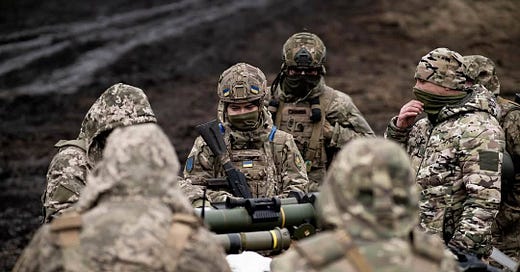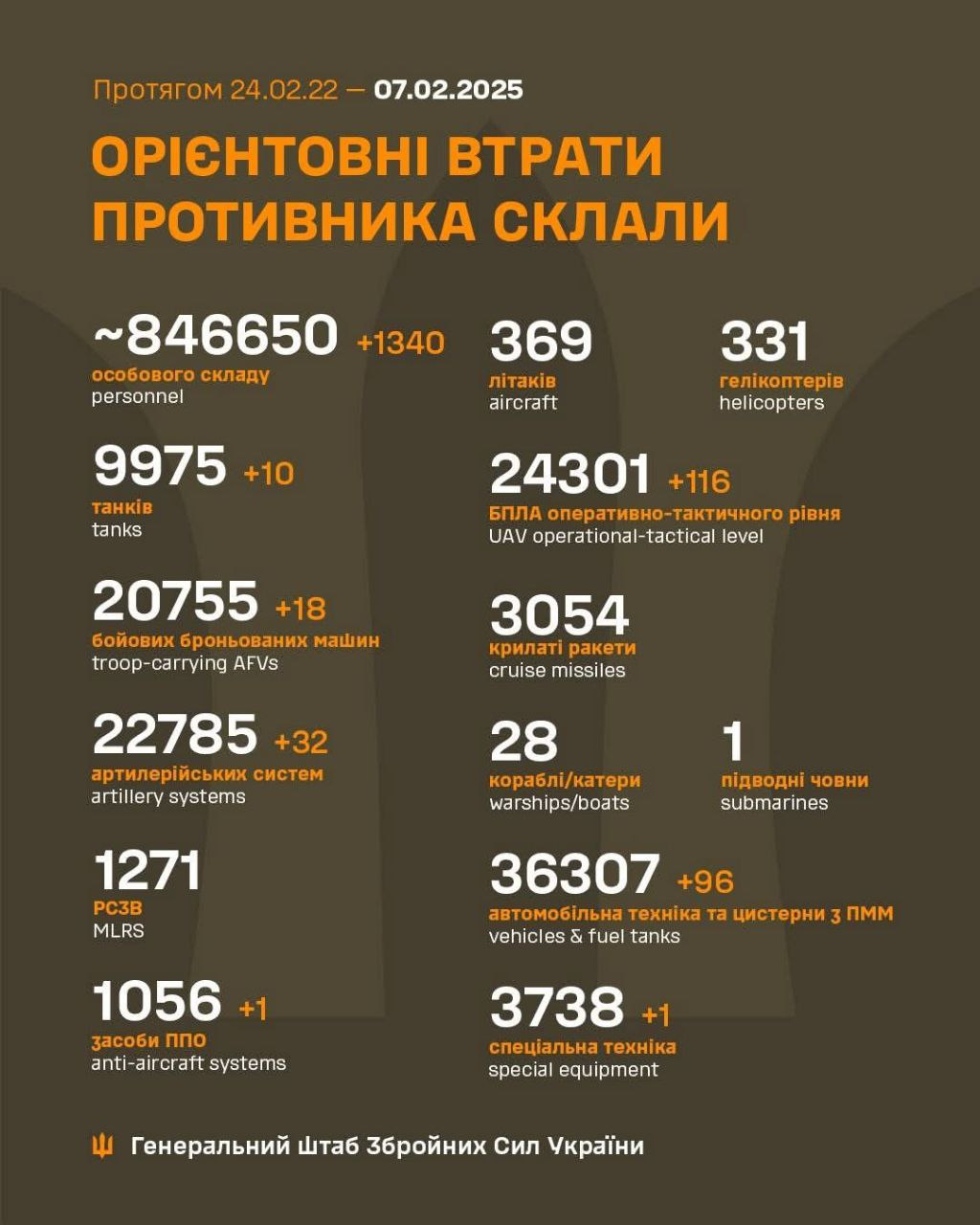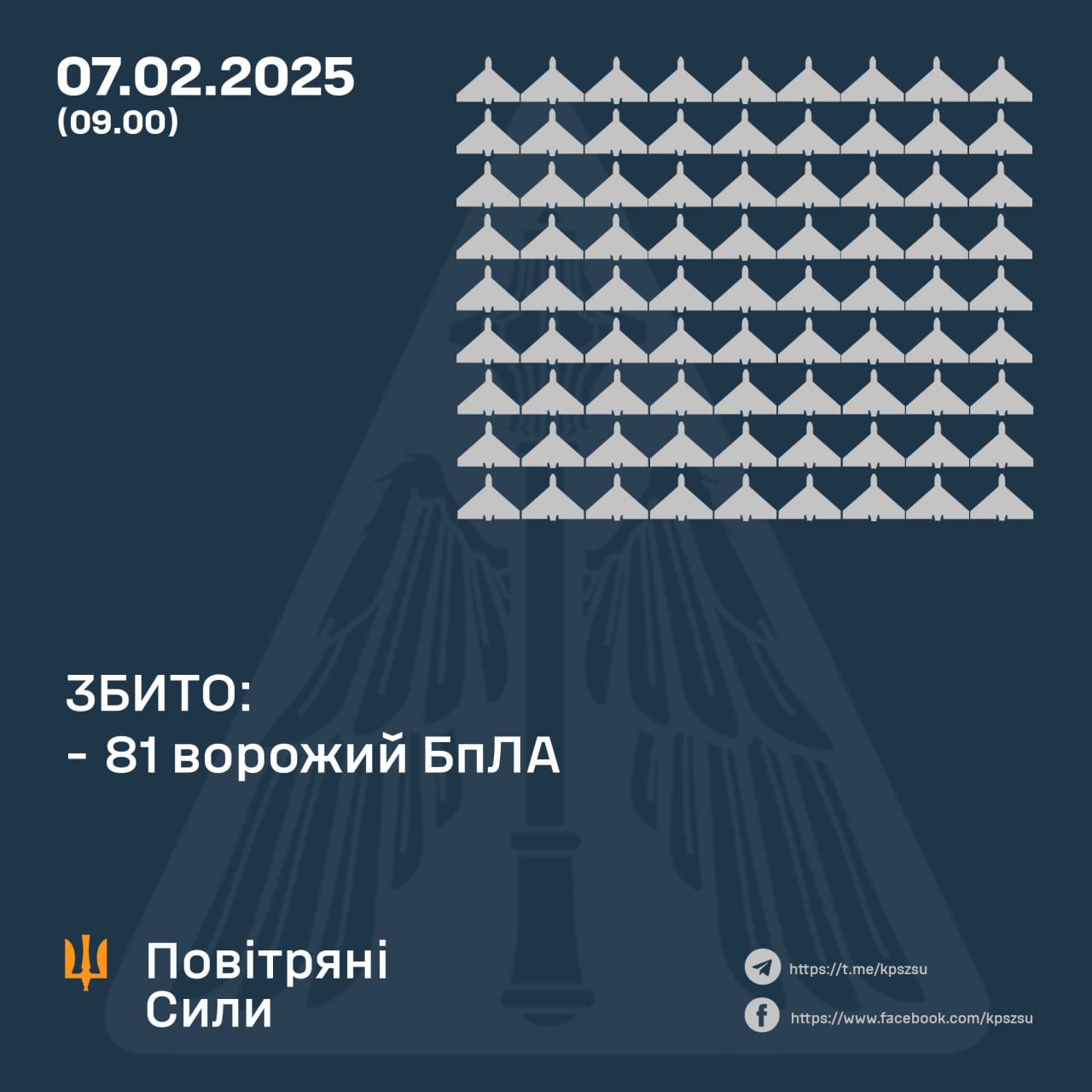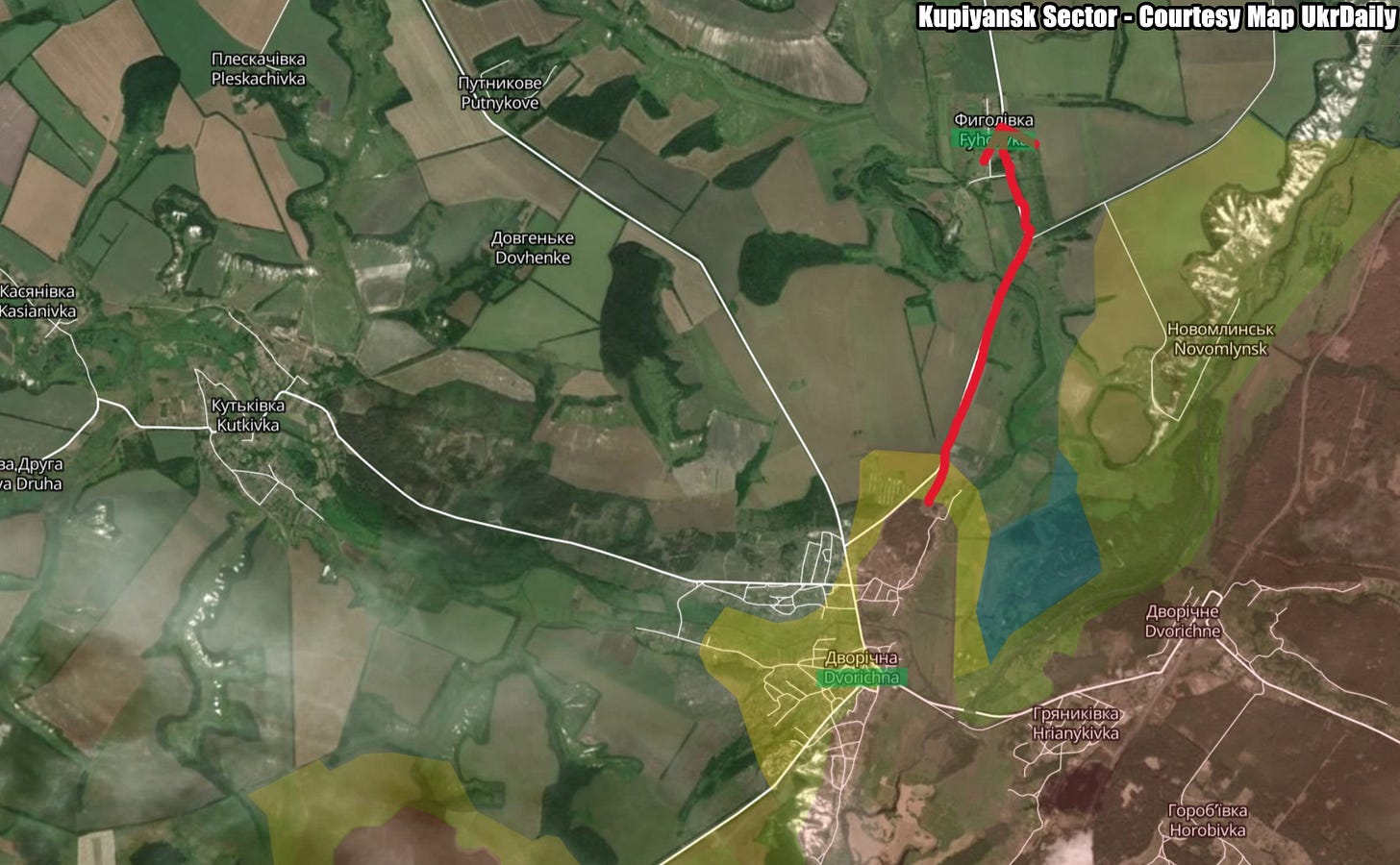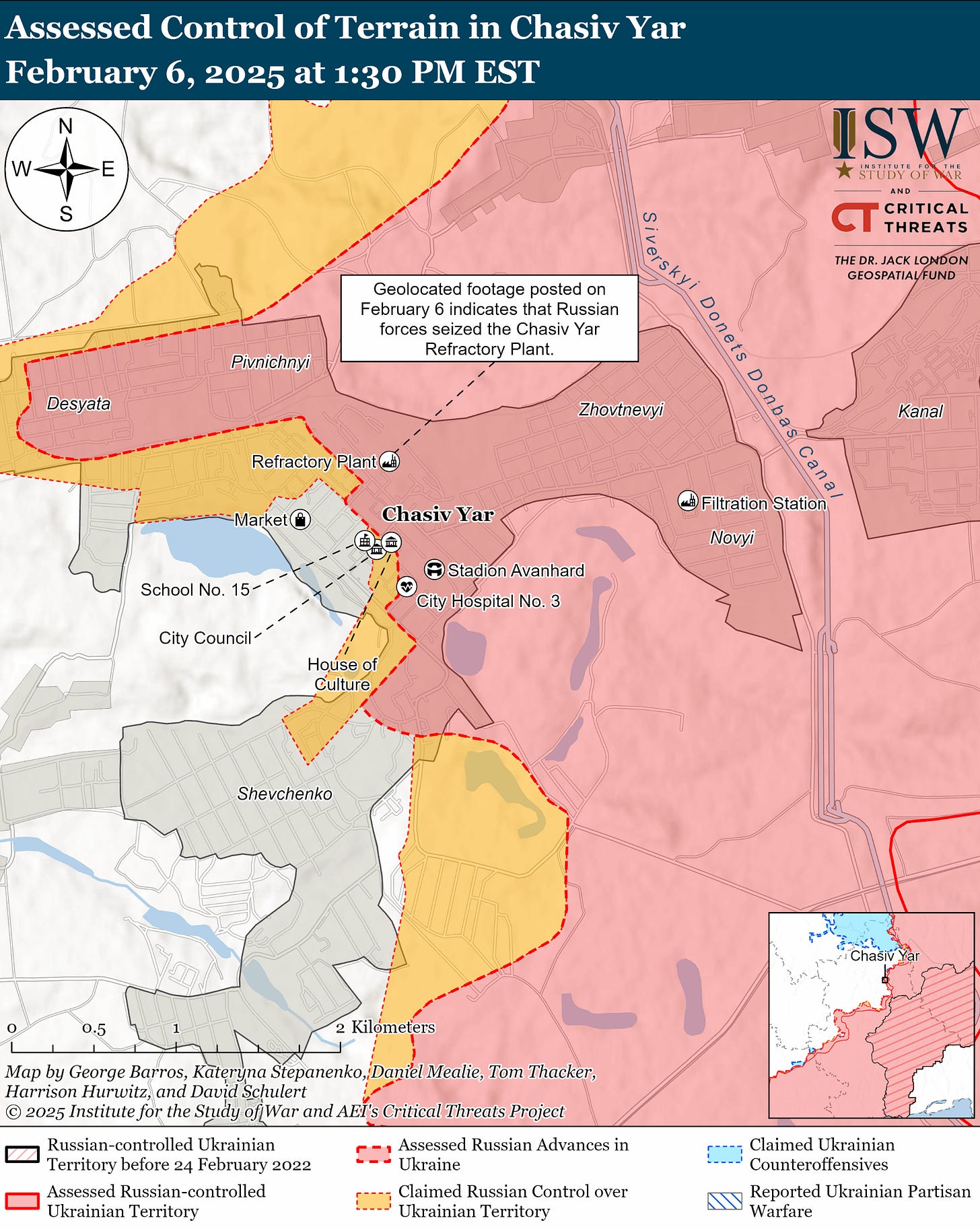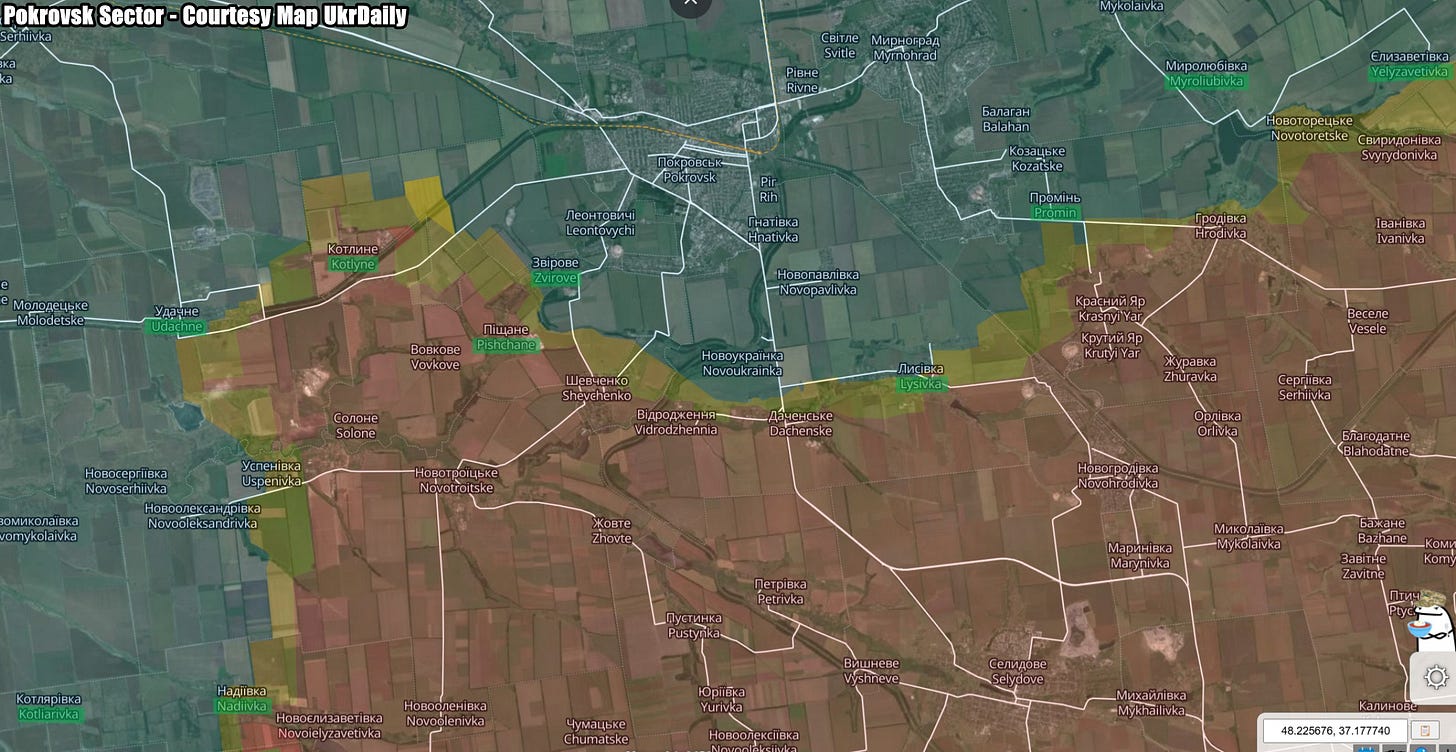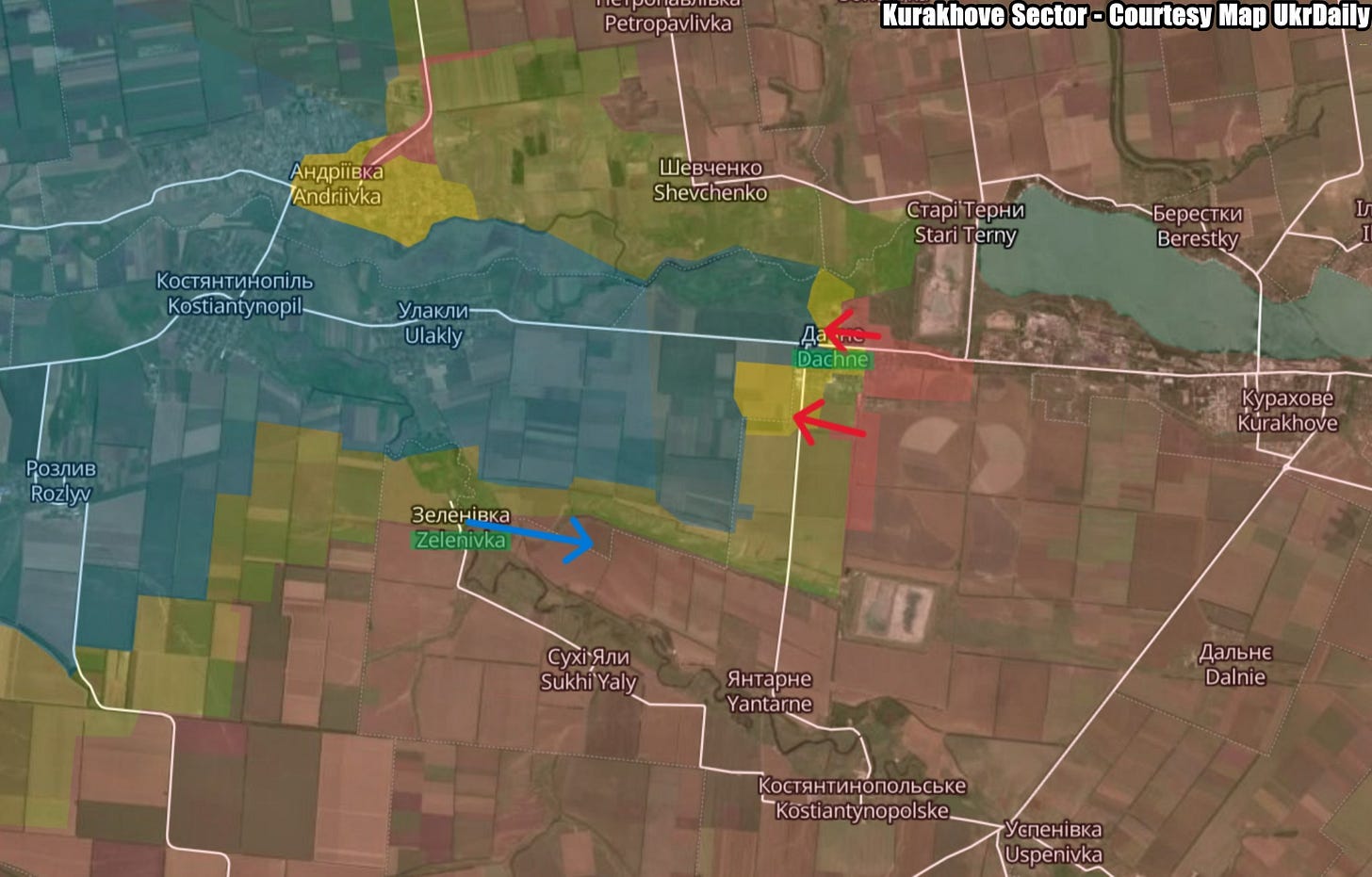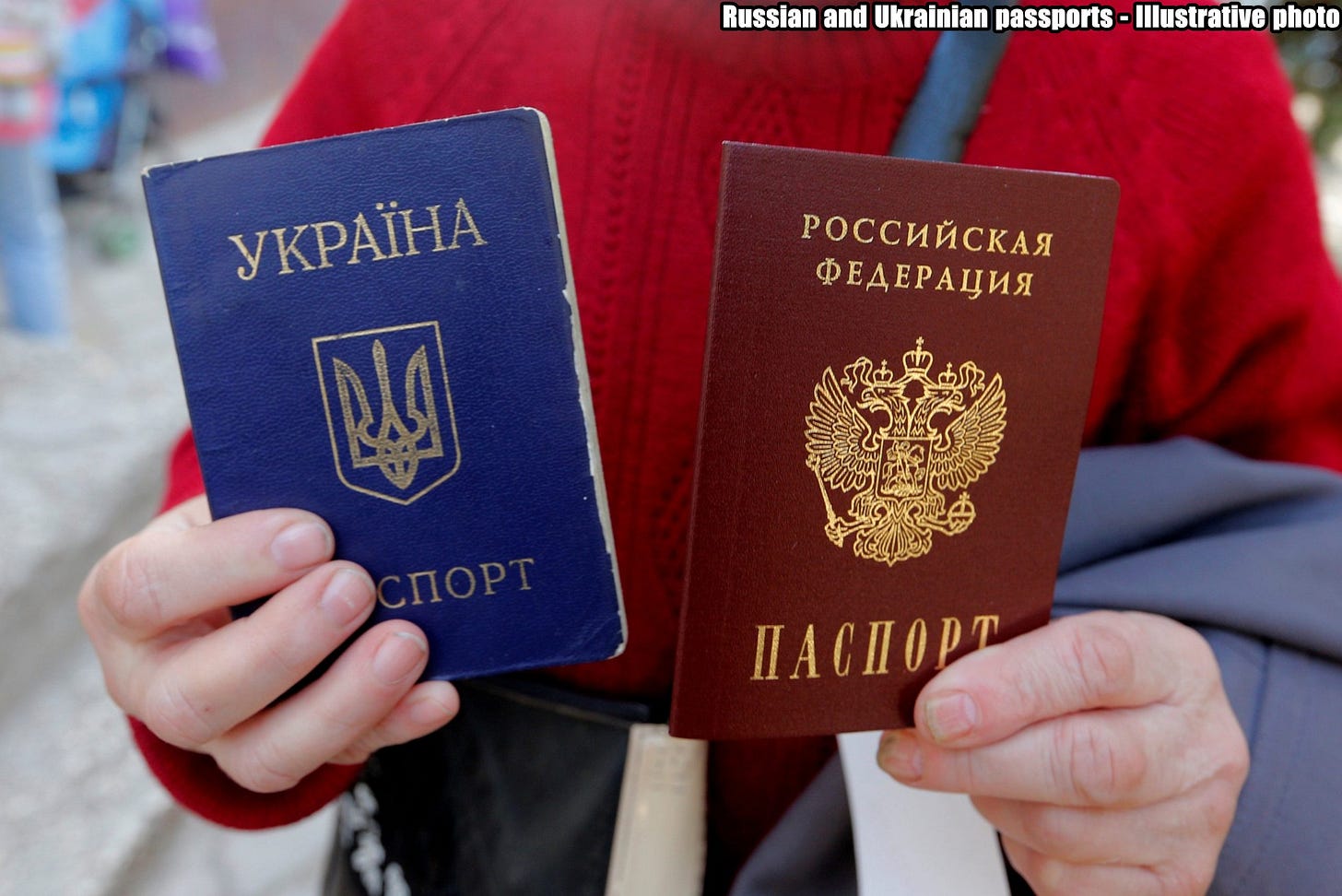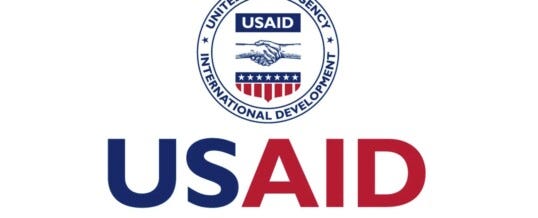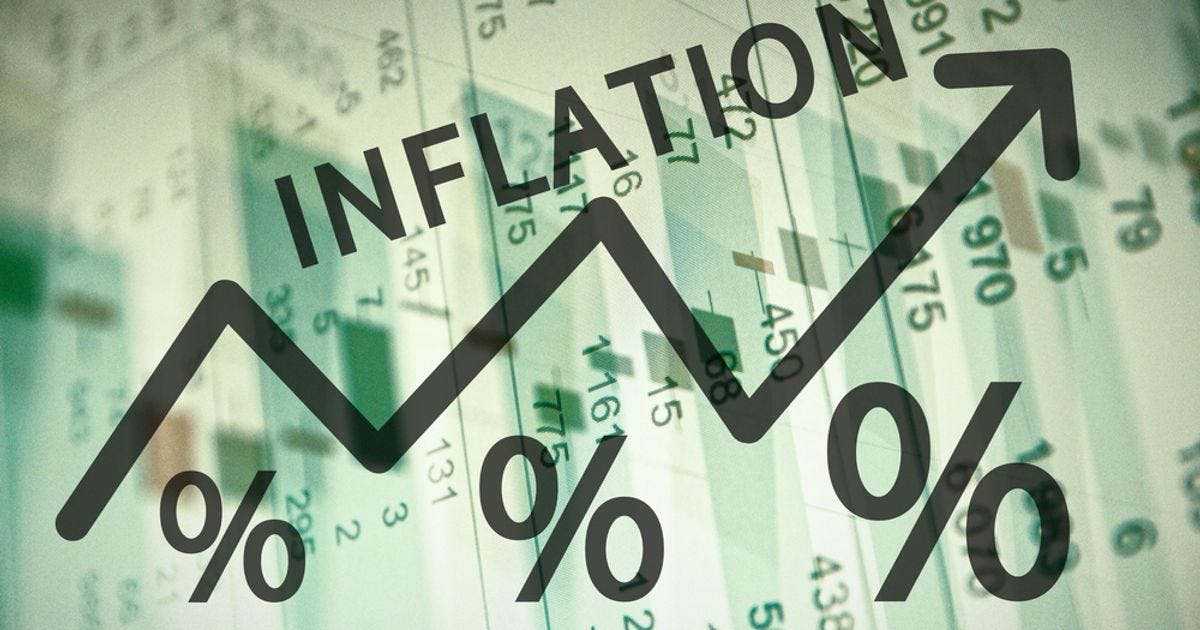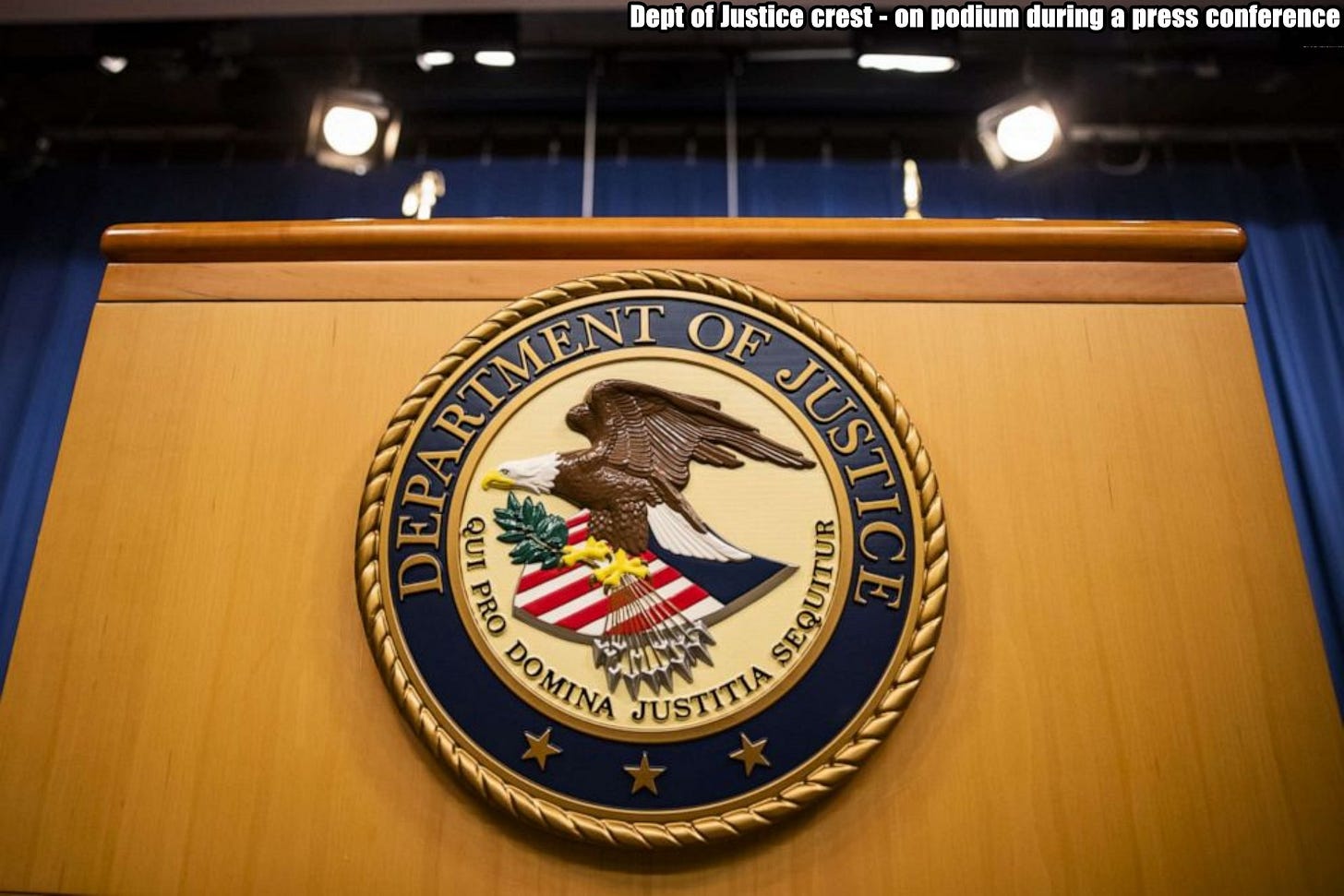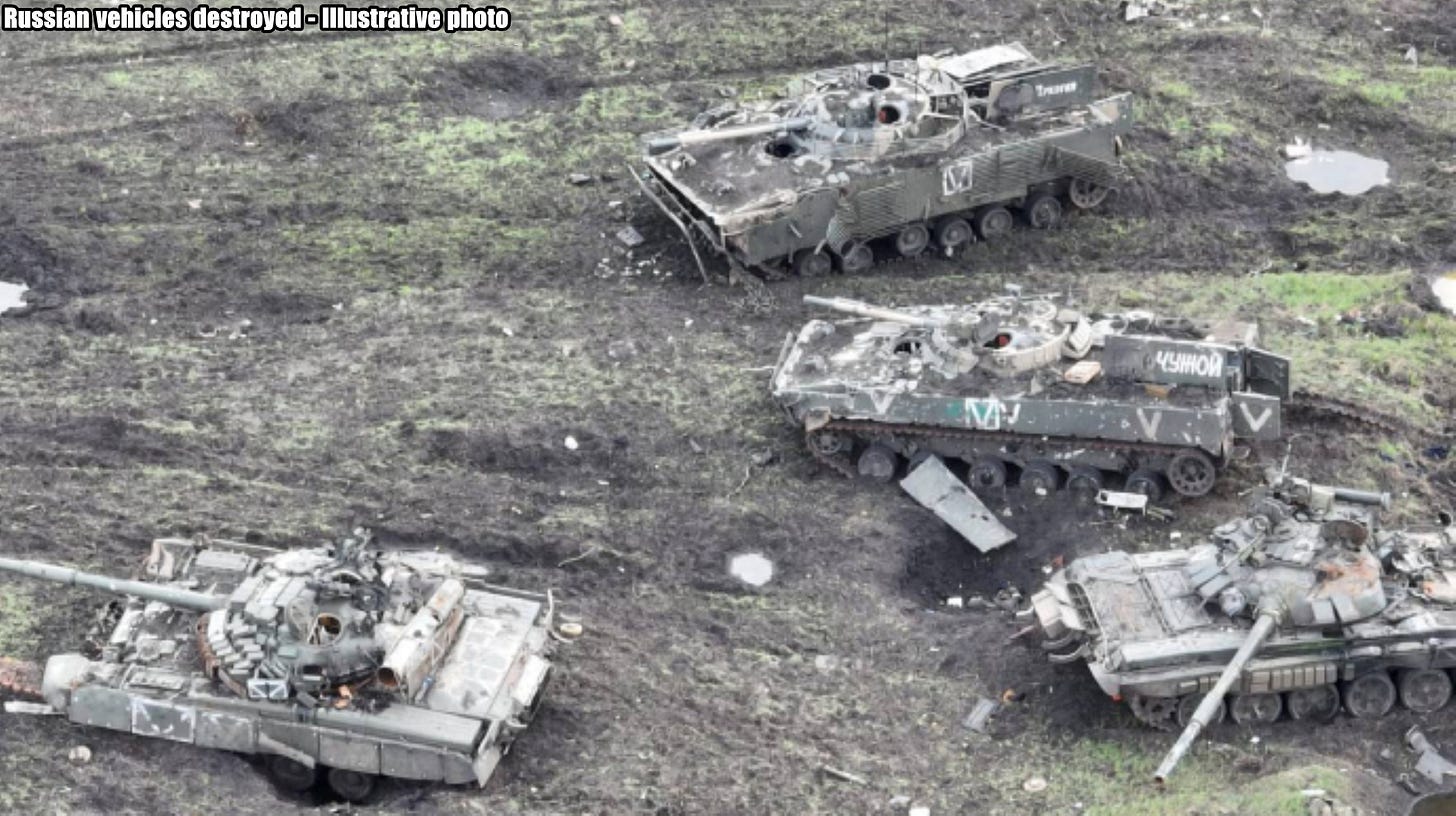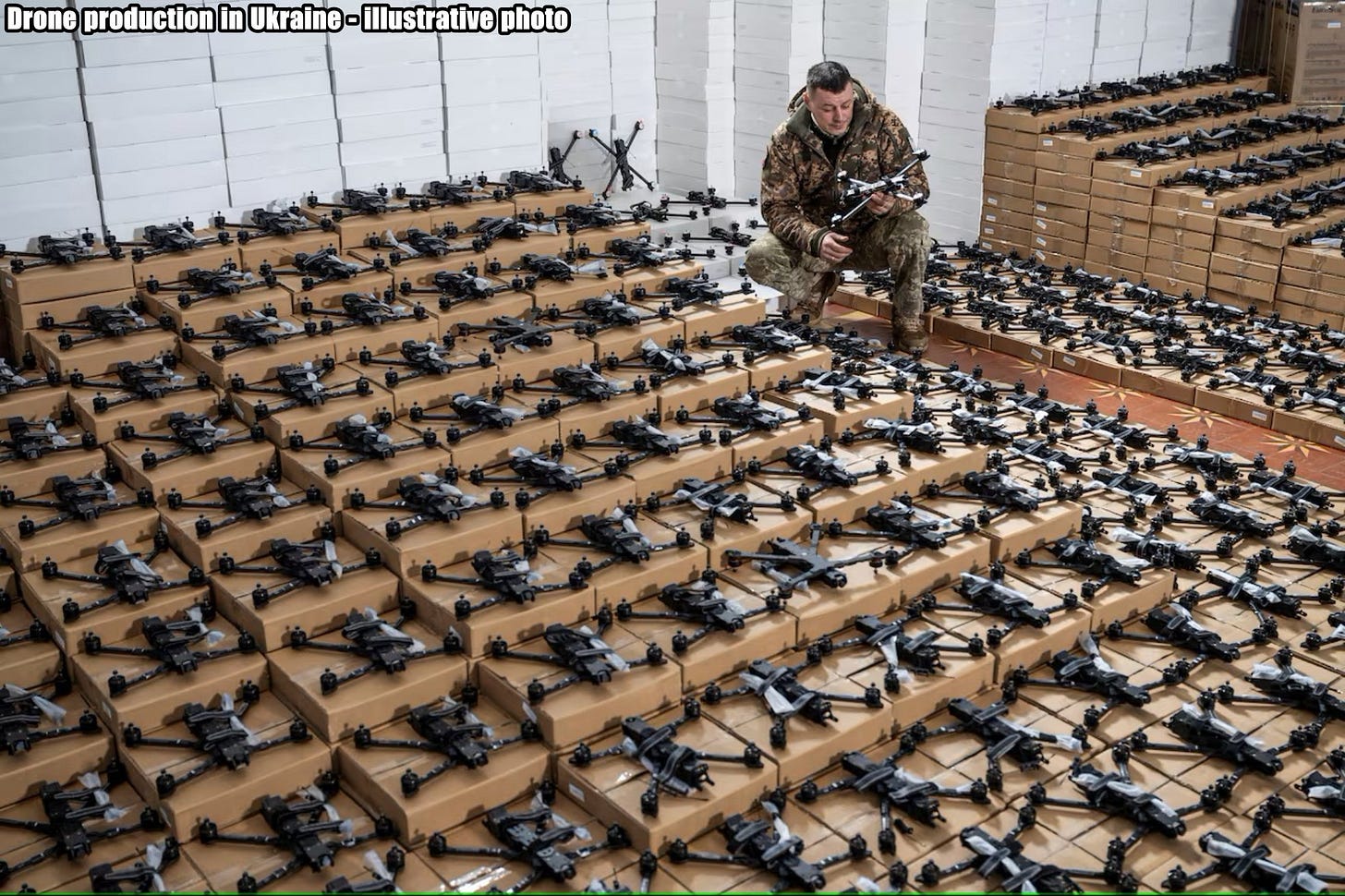Slava Ukraini! In early 2022 I began a Telegram channel aggregating news from a number of sources daily on the war in Ukraine. In June 2023 I began providing a daily draft for the Ukraine War Brief Podcast collecting news from over 70 sources daily, which formed the basis of the script. While the Podcast no longer exists I have continued to make this Brief available for my followers here on Substack for those who wish to keep up with the news from the war.
All the latest news on the Russo-Ukraine War 6 days per week
ALONG THE CONTACT LINE
GSAFU Morning Report
The General Staff of the Armed Forces of Ukraine in its Operational Information update at 08:00 on Feb 7 stated that day 1080 of the full-scale invasion of the Russian Federation against Ukraine had begun.
The situation on the line of combat remains tense in some sectors. Ukrainian defenders continue to actively counteract the Russian aggressor, causing them significant losses in personnel, equipment and technology. Exhausting the enemy along the entire front line and continuing to disrupt the plans of Russian occupiers to advance deeper into the territory of Ukraine.
During the past day, 101 combat engagements took place.
Over the past 24 hours, the enemy carried out 3 missile strikes, 84 air strikes, used 2,829 drones and fired approximately 5,000 artillery shells across the positions of Ukrainian forces and civilians.
Air Force Daily Report
81 ENEMY UAVS SHOT DOWN, 31 DROIDS DID NOT REACH THEIR TARGETS (LOCATIONALLY LOST)
➖➖➖➖➖➖➖➖➖
On the night of February 7, 2025 (from 7:00 p.m. on February 6), the enemy attacked with 112 Shahed attack UAVs and simulator drones of various types from the directions: Kursk, Orel, Millerovo, Bryansk, Shatalovo — Russia.
The air attack was repelled by aviation, anti-aircraft missile troops, electronic warfare units, and mobile fire groups of the Air Force and Defense Forces of Ukraine.
As of 09:00, the shooting down of the 81st Shahed attack UAV and other types of drones in Kharkiv, Poltava, Sumy, Kyiv, Cherkasy, Chernihiv, Kirovohrad, Zhytomyr, Khmelnytskyi, Zaporizhia, Dnipropetrovsk, Mykolaiv and Odessa regions was confirmed.
31 enemy drone simulators — lost in location (without negative consequences).
As a result of the enemy attack, the Sumy, Kyiv, and Khmelnytskyi regions suffered.
Combat Operations in the Kursk Sector, Russian Federation
Ukrainian forces launch new offensive.
The Institute for the Study of War (ISW), a US based think tank, in its Feb 6 Russian Offensive Campaign Assessment reported that on the 6 month anniversary of their initial incursion, Ukrainian forces launched a new series of battalion-sized mechanized assaults in Kursk Oblast and advanced up to five kilometers behind Russian lines southeast of Sudzha, Kursk Oblast on Feb 6.
Geolocated footage published on Feb 6 indicates that Ukrainian forces recently advanced southwest of Makhnovka (southeast of Sudzha) and north and east of Cherkasskaya Konopelka (southeast of Sudzha) along the 38K-028 Sudzha-Oboyan highway and seized Kolmakov (north of Cherkasskaya Konopelka) and Fanaseyevka (just southeast of Cherkasskaya Konopelka).
The Russian Ministry of Defense (MoD) claimed that Ukrainian forces attacked in several waves in the direction of Cherkasskaya Konopelka and Ulanok (southeast of Cherkasskaya Konopelka along the 38K-028 highway) with up to two mechanized battalions' worth of armored vehicles and that Russian forces repelled the attack.
Russian milbloggers estimated that Ukrainian forces attacked with 30 to 50 armored vehicles and claimed that one group of Ukrainian forces successfully attacked from Makhnovka towards Cherkasskaya Konopelka, Fanaseyevka, and Ulanok.
Some Russian sources claimed that Ukrainian forces broke through to or even seized Ulanok, but other sources also denied these claims. ISW has not yet observed geolocated evidence to assess that Ukrainian forces are operating in Ulanok. The Ukrainian General Staff published a map on February 6 indicating that Russian forces recently marginally advanced in a forested area southwest of Kurilovka.
A Kremlin-affiliated Russian milblogger claimed that there are unconfirmed reports that Ukrainian forces also attacked near Kruglenkoye (northwest of Sudzha), but ISW did not observe additional claims of Ukrainian activity in this area or north of Sudzha near Berdin where Ukrainian forces attacked in early January 2025. Russian milbloggers claimed that Ukrainian forces launched the attacks southeast of Sudzha during poor weather conditions that complicated Russian drone operations in the area. Some Russian milbloggers expressed concern that further Ukrainian advances in Kursk Oblast could threaten rear areas of the Russian force grouping attacking Guyevo (south of Sudzha) and complicate Russia's ability to interdict Ukrainian ground lines of communication (GLOCs) within the Ukrainian salient.
Russian sources acknowledged that elements of the Russian 11th Airborne (VDV) Brigade, 810th Naval Infantry Brigade (Black Sea Fleet), 30th Motorized Rifle Regiment (72nd Motorized Rifle Division, 44th Army Corps [AC], Leningrad Military District [LMD]), and 177th Naval Infantry Regiment (Caspian Flotilla) and Chechen Akhmat drone operators are the main forces defending against the Ukrainian attacks southeast of Sudzha
The Khortytsia operational-strategic group
(Responsible for the northeastern part of Ukraine. )
Kupyansk Sector: Russian forces recently advanced in the Kupyansk direction amid continued offensive operations in the area on Feb 6. Russian forces continued attacking east of Kupyansk near Petropavlivka on Feb 5 and 6.
Geolocated footage published on Feb 6 indicates that Russian forces recently advanced on the west bank of the Oskil River along the O-210921 highway, into Fyholivka (northeast of Kupyansk and north of Dvorichna), and seized the settlement.
Chasiv Yar Sector: Russian forces recently advanced in Chasiv Yar amid continued offensive operations near Chasiv Yar itself and to the south near Stupochky on Feb 5 and 6
The Tavria operational-strategic group
(Responsible for the central-eastern and southeastern part of Ukraine.)
Pokrovsk Sector : Russian forces continued offensive operations near Pokrovsk on Feb 6 but did not advance. Russian forces continued assaults east of Pokrovsk near Tarasivka, Vodyane Druhe, Yelyzavetivka, Myrolyubivka, and Promin; southeast of Pokrovsk near Lysivka; south of Pokrovsk near Pishchane and Zvirove; and southwest of Pokrovsk near Kotlyne, Udachne, Nadiivka, Kotlyarivka, Uspenivka, Sribne, and Zaporizhzhia on Feb 5 and 6.
Kurakhove Sector: Ukrainian and Russian forces recently advanced west of Kurakhove amid ongoing offensive operations in the area on Feb 6. Russian forces continued attacks northwest of Kurakhove near Shevchenko and Andriivka, west of Kurakhove near Dachne and Kostyantynopil, and southwest of Kurakhove near Ulakly on Feb 5 and 6.
Geolocated footage published on Feb 6 indicates that Ukrainian forces recently advanced east of Zelenivka (southwest of Kurakhove)
Geolocated footage published on Feb 6 indicates that elements of the Russian 68th Tank Regiment (150th Motorized Rifle Division, 8th CAA, SMD) recently advanced into northwestern Dachne, seized Dachne, and likely pushed Ukrainian forces from positions in the fields immediately north and south of the settlement.
The Odesa operational-strategic group
(Responsible for Kherson, Qırım, (also known as Crimea) and the Black Sea.)
There have been no major changes to the combat environment since our last report.
TEMPORARILY OCCUPIED TERRITORIES
Russia will not provide insulin and other life-saving medicines in occupied territories without Russian passport.
The Russian invaders in the occupied territories, as part of the forced passportization, ordered to ban the sale of life-saving drugs in pharmacies to people who have not have a Russian passport.
This was reported by the press service of the Defense Intelligence of Ukraine, Censor.NET reports.
"In particular, insulin and thyroid drugs are banned. In addition, since February 2025, the Russian occupation administrations have been prohibiting the provision of medical care to all those who have refused to illegally acquire the citizenship of the aggressor state," the statement said.
Also, the invaders stopped paying pensions to elderly people who remain in occupation without Russian passports since the beginning of 2025.
"People who try to avoid their interaction and cooperation with the Russian occupation authorities are threatened with deportation to remote regions of the Russian Federation. The male population in the occupation is under constant pressure from Muscovites and the threat of forced mobilization into the Russian occupation army.
The situation in the occupied territories of Ukraine illustrates the systematic violation of international law by the aggressor state of Russia and the continuation of its criminal genocidal policy towards the Ukrainian people," the Defence Intelligence of Ukraine summarized.
THE HOME FRONT
Ukraine secures preliminary deals to replace USAID funding for critical projects.
Ukraine is working to secure alternative funding sources for critical programs previously supported by the U.S. Agency for International Development (USAID) and has already reached preliminary agreements on some, the Kyiv Independent reported citing Deputy Prime Minister and Justice Minister Olha Stefanishyna on Feb. 7.
"The negotiations are ongoing. Ministers in the Ukrainian government have held meetings on critical programs — Energy, Infrastructure, Digital Transformation, and Justice Ministries," she said at a conference. Stefanishyna emphasized that urgent funding has already been identified for recovery efforts, energy resilience, and cyber defense projects.
She also noted that the European Commission and Group of Seven (G7) countries are expected to announce a decision on resuming the work of commissions responsible for appointing key members of Ukraine's judiciary and anti-corruption institutions in the coming days.
Due to the suspension of USAID's operations in Ukraine, several commissions involved in judicial selections have either halted work or faced operational issues.
"As far as I know, the contracts have been terminated, and we must reassemble this puzzle," Stefanishyna said, stressing the need for international partners to uphold their joint responsibility in supporting Ukraine's reforms.
USAID has funded a wide range of initiatives in Ukraine, from energy security to civil society development. U.S. President Donald Trump ordered a 90-day freeze on all foreign assistance upon taking office, effectively halting USAID-funded programs worldwide.
Trump's administration is reportedly planning to eliminate most positions at USAID, The New York Times reported on Feb. 6, citing sources familiar with the matter.
U.S. Secretary of State Marco Rubio, whom Trump appointed as acting administrator of USAID, reiterated on Feb. 4 that U.S. foreign aid must serve American interests rather than function as "charity."
Billionaire Elon Musk, now head of the Department of Government Effectiveness (DOGE), has called USAID "a criminal organization" and claimed on Feb. 3 that Trump agreed to shut it down.
Grumpy Here - It should be noted that USAID was reportedly investigating Musk - specifically his shutting down of Starlink (the use of which had been paid for through USAID in Ukraine at a crucial time during the war following a private phone call with Vladimir Putin.
RUSSIAN WORLD
Inflation Remains ‘Challenge’ for Russian Economy, Putin Admits.
Russian President Vladimir Putin on Friday acknowledged that inflation remains a major “challenge” for the country’s economy and ordered the government to work on lowering it in 2025. The Moscow Times reports.
Consumer prices in Russia rose by 9.5% in 2024 and have climbed further to 9.9% year-on-year this month, Putin said during a televised meeting at the Kremlin with Prime Minister Mikhail Mishustin.
“That’s a challenge for us. We need to do everything necessary to ensure balanced growth,” Putin said, according to a Kremlin-published transcript of the sit-down.
“The task for this year is to reach a balanced growth trajectory, to reduce inflation,” the Kremlin leader added. “As we agreed, I am waiting for the government’s plan of measures to advance structural changes in the economy.”
Mishustin, in his turn, told the Russian president that the economy grew by 4.1% in 2024. That was the same as the pace of growth in 2023, he said, revising up the previous figure of 3.6% growth for that year.
The prime minister also agreed with Putin that it was “absolutely clear that the main challenge is inflation.”
Russia’s Central Bank said earlier this week that it saw “no signs of a sustainable slowdown in price growth” despite maintaining a record-high key interest rate of 21%.
The regulator cited Western sanctions, the ruble’s depreciation and a weak harvest as key drivers of inflation. Likewise, defense spending is turbocharging demand, which continues to outpace the economy’s ability to supply goods and services.
Russia’s Central Bank forecasts inflation to ease to between 5.2% and 8.6% by the end of 2025. The bank is set to hold its next rate meeting on Feb. 14.
INTERNATIONAL NEWS
Trump administration disbands task force targeting Russian oligarchs.
The U.S. Justice Department under President Donald Trump is disbanding an effort started after Russia's 2022 invasion of Ukraine to enforce sanctions and target oligarchs close to the Kremlin. Reuters reported on Feb 6.
A memo from Attorney General Pam Bondi, issued on Wednesday during a wave of orders on her first day in office but not previously reported, said the effort, known as Task Force KleptoCapture, will end as part of a shift in focus and funding to combating drug cartels and international gangs.
"This policy requires a fundamental change in mindset and approach," Bondi wrote in the directive, adding that resources now devoted to enforcing sanctions and seizing the assets of oligarchs will be redirected to countering cartels.
The effort, launched during Democratic President Joe Biden's administration, was designed to strain the finances of wealthy associates of Russian President Vladimir Putin and punish those facilitating sanctions and export control violations.
It was part of a broader push to freeze Russia out of global markets and enforce wide-ranging sanctions imposed on Moscow amid international condemnation of its war in Ukraine.
The task force brought indictments against aluminum magnate Oleg Deripaska and TV tycoon Konstantin Malofeyev for alleged sanctions busting, and seized yachts belonging to sanctioned oligarchs Suleiman Kerimov and Viktor Vekselberg.
It also secured a guilty plea against a U.S. lawyer who made $3.8 million in payments to maintain properties owned by Vekselberg.
Prosecutors assigned to the task force will return to their previous posts. The changes will be in effect for at least 90 days and could be renewed or made permanent, according to the directive.
Trump has spoken about improving relations with Moscow. He has previously vowed to end the war in Ukraine, though he has not released a detailed plan.
The emphasis on drug cartels comes after Trump designated many such groups as terrorist organizations, part of a crackdown on illegal immigration and fentanyl trafficking.
The shift also implicates enforcement of a U.S. foreign bribery law that has led to some of the Justice Department's largest corporate cases over the last decade. The unit enforcing that law, known as the Foreign Corrupt Practices Act, will now prioritize bribery investigations related to cartels, according to the memo.
A wide range of multinational firms has come under Justice Department scrutiny over the law, including Goldman Sachs, Glencore and Walmart. Those large corporate resolutions do not typically involve cartels.
"It is a radical move away from traditional FCPA cases and toward a narrow subset of drug and violent crime related cases that have never been the focus of FCPA enforcement," said Stephen Frank, a lawyer at law firm Quinn Emanuel Urquhart & Sullivan who worked on FCPA cases as a federal prosecutor.
MILITARY & TECH
UK Intel - Russia see diminishing gains for a horrendous expenditure of lives
The UK Ministry of Defence in their Feb 7 Intelligence Update on Ukraine stated that in Jan 2025, Russia’s territorial advances in Ukraine slowed as they took approximately 320 sq km, compared with approximately 400 sq km in Dec 2024. Russia seized control of the stronghold of Velyka Novosilka, but advances along most of the frontline have been relatively minor. Through 2024, Russian advances had been accelerating, with over 700 sq km taken in Nov 2024, one of the quickest rates of advance since the early stages of the conflict.
In Russia’s Kursk oblast, Russia made minor advances in January 2025. Democratic People’s Republic of Korea units which had been deployed on offensive combat operations in Kursk Oblast have temporarily withdrawn from frontline positions, likely to rest and refit before redeploying. This is almost certainly primarily due to heavy losses sustained during attacks against Ukrainian-held positions.
Defence Ministry - Ukraine is now ahead of Russia in manufacturing FPV drones.
The drone industry in Ukraine is developing at a breakthrough pace. Last year, more than 250 new models of UAVs of various types and purposes were approved for use in the Defence Forces.
Censor.NET reported this citing First Deputy Minister of Defence of Ukraine Lieutenant General Ivan Havryliuk in an interview with "Ukrinform".
"If we talk about the production of FPV drones, Ukraine is currently ahead of the Russian Federation. Both in terms of development and production. Since 24 February 2022, more than 1,300 new models of weapons and military equipment produced by Ukrainian enterprises have been codified for the needs of the Defence Forces. The largest group of them is the UAVs and ammunition for them. Last year alone, more than 250 new UAV models of various types and purposes were approved for use in the Defence Forces. However, it should be understood that the determining factor is not only the number of drones developed and manufactured," Havryliuk said.
He emphasised that the efficiency of their use and the speed with which developers can respond to changes are crucial.
"You can have hundreds of thousands of drones, but they will be powerless against the enemy's countermeasures, as I mentioned above. After a month or three in a cluster of drones, the effectiveness of a particular model decreases. We need to look for new ways to maintain efficiency. The technological ‘duel’ between manufacturers of drones and electronic warfare equipment clearly illustrates this. And here, the advantage is on the side of the one whose engineers are quicker to offer a technological solution to which the enemy will not have a ready answer. Recall drones with artificial intelligence elements. Or the increasing use of fibre-optic drones as a response to the dominance of electronic warfare technologies," Havryliuk added.
That’s it for today’s Brief folks if you would like to keep up with events in Ukraine daily please consider subscribing, it’s free!


